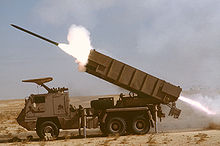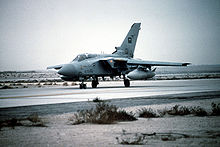- Armed Forces of Saudi Arabia
-
Saudi Arabian Armed Forces 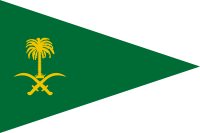
Service branches Royal Saudi Air Force
Royal Saudi Land Forces
Royal Saudi Navy
Royal Saudi Air Defense
Saudi Arabian National Guard
Saudi Royal Guard Regiment
Saudi Emergency ForceHeadquarters Riyadh, Saudi Arabia Leadership Commander-in-Chief King Abdallah bin Abdul-Aziz al-Saud Minister of Defense Prince Salman bin Abdul-Aziz Al Saud Chief of staff Lt. General Salih ibn Ali al-Muhaya Manpower Military age 18 years of age Available for
military service8,240,714, age 15-49 (2004) Fit for
military service4,725,514, age 15-49 (2004) Reaching military
age annually246,343 (2004) Active personnel 233,500[1] (ranked 24th) Expenditures Budget $39.2 billion (2009)[2] Percent of GDP 8.2%[2] Industry Foreign suppliers  France
France
 China
China
 Germany
Germany
 United Kingdom
United Kingdom
 Russia
Russia
 Brazil
Brazil
 United States
United StatesRelated articles Ranks Saudi Arabian military ranks Saudi Arabia's armed forces are mainly the responsibility of the Ministry of Defense and Aviation. The Ministry also has responsibility for the construction of civilian airports as well as military bases, and for Meteorology departments. However, the Saudi Arabian National Guard is independent of the Ministry, and is commanded by King Abdullah's son, Prince Mutaib bin Abdullah.
Crown Prince Sultan bin Abdulaziz had held the portfolio of Saudi Arabia's Minister of Defence and Aviation since 1962 to 2011. The Vice Minister, Abdulrahman bin Abdulaziz, is his full brother. His oldest son, Khalid bin Sultan, was appointed Assistant Minister of Defence for Military Affairs in 2001.
Contents
Overview
The Saudi military consists of the Saudi Army, the Royal Saudi Air Force, the Royal Saudi Navy, the Royal Saudi Air Defense, the Saudi Arabian National Guard - the 'SANG', and paramilitary forces, totaling over 200,000 active-duty personnel. In 2005 the armed forces had the following personnel: the army, 75,000; Royal Saudi Air Force, 18,000; air defense, 16,000; Royal Saudi Navy, 15,500 (including 3,000 marines); and the SANG had 75,000 active soldiers and 25,000 tribal levies.[3] In addition, there is a military intelligence service.
The SANG is not a reserve but a fully operational front-line force, and originated out of Abdul Aziz’s tribal military-religious force, the Ikhwan. Its modern existence, however, is attributable to it being effectively Abdullah’s private army since the 1960s and, unlike the rest of the armed forces, is independent of the Ministry of Defense and Aviation. The SANG has been a counter-balance to the Sudairi faction in the royal family: Prince Sultan, the Minister of Defense and Aviation, is one of the so-called ‘Sudairi Seven’ and controls the remainder of the armed forces.[4]
Military organization and equipment
Army
The army is composed of three armored brigades, five mechanized brigades, one airborne brigade, one Royal Guard brigade, and eight artillery battalions. The army also has one aviation command with two aviation brigades.[3]
The army’s main equipment consists of a combination of French- and U.S.-made armored vehicles: 315 M–1A2 Abrams, 290 AMX–30, and 450 M60A3 main battle tanks; 300 reconnaissance vehicles; 570+ AMX–10P and 400 M–2 Bradley armored infantry fighting vehicles; 3,000+ M113 and 100 Al-Fahd armored personnel carriers, produced in Saudi Arabia; 200+ towed artillery pieces; 110 self-propelled artillery pieces; 60 multiple rocket launchers; 400 mortars; 10 surface-to-surface missiles; about 2,000 antitank guided weapons; about 200 rocket launchers; 450 recoilless launchers; 12 attack helicopters; 50+ transport helicopters; and 1,000 surface-to-air missiles.[3] In 2011, the Saudi-Arabian army has furthermore ordered 200+ German Leopard 2A7+ main battle tanks to extend their fleet.
Airforce
The air force is organized in seven fighter/ground-attack squadrons, six fighter squadrons, and seven training squadrons. Saudi Arabia has at least 15 active military airfields.[3]
As of 2011, Saudi Arabia has around 300 combat aircraft. The kingdom's combat aircraft are newly acquired Eurofighter Typhoons and upgraded Tornado IDS, F-15 Eagle and F-15E Strike Eagle fighter planes. Saudi Arabia has a further 80+ F-15 Eagles on order and an option to buy another 72 Eurofighter Typhoons.
Air Defense
Air Defense was part of the Army until 1981 when it was made a separate service. It operates "Peace Shield" a state-of-the-art radar and air defense system consisting of a Command Operations Center at Riyadh, and main operating bases at Dhahran, Taif, Tabuk, Khamis Mushait and Al Kharj. The total system includes 164 sites.[5]
The system equipment comprises 17 General Electric AN/ FPS-117 long-range 3-D radars, 6 Northrop Grumman AN/TPS-43 tactical radars, and Raytheon Improved HAWK air defence missile system[5]
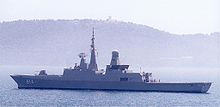 HMS "Makkah", an Al Riyadh class frigate.
HMS "Makkah", an Al Riyadh class frigate.
The navy is divided into two fleets: the Western Fleet has bases in Jeddah, Jizan, and Al Wajh; the Eastern Fleet has bases in Al Jubayl, Ad Dammam, Ras al Mishab, and Ras al Ghar. The marines are organized into one infantry regiment with two battalions.[3]
The navy’s inventory includes 11 principal surface combatants, 65 patrol and coastal combatants, 7 mine warfare vessels, 8 amphibious craft, and 7 support and miscellaneous craft. Naval aviation forces have 19 helicopters (armed) serving in naval support.[3]
SANG
The Saudi Arabian National Guard is independent of the Ministry of Defense & Aviation and is organized into three mechanized infantry brigades, five infantry brigades, and one ceremonial cavalry squadron.
The SANG is equipped with 100 Saudi manufactured Al-Fahd infantry fighting vehicles.[6] It will be strengthened by the purchase of US$1 billion worth of new armored vehicles from the United States.[3]
Defense spending
Spending on defense and security has increased significantly since the mid-‘90s and was about US$25.4 billion in 2005. Saudi Arabia ranks among the top 10 in the world in government spending for its military, representing about 7 percent of gross domestic product in 2005. Its modern high-technology arsenal makes Saudi Arabia among the world’s most densely armed nations, with its military equipment being supplied primarily by the US, France and Britain.[3]
The United States sold more than $80 billion in military hardware between 1951-2006 to the Saudi military.[7] In comparison, the Israel Defense Forces received $53.6 billion in US military grants between 1949-2007.[8] On October 20, 2010, U.S. State Department notified Congress of its intention to make the biggest arms sale in American history - an estimated $60.5 billion purchase by the Kingdom of Saudi Arabia. The package represents a considerable improvement in the offensive capability of the Saudi armed forces.[9] The U.S. was keen to point out that the arms transfer would increase "interoperability" with U.S. forces. In the 1990-1991 Gulf War, having U.S.-trained Saudi forces, along with military installations built to U.S. specifications, allowed the American armed forces to deploy in a comfortable and familiar battle environment. This new deal would increase these capabilities, as an advanced American military infrastructure is about to be built.[10] The US government is also in talks with Saudi Arabia about the potential sale of advanced naval and missile-defense upgrades worth up to tens of billions of dollars.[11]
The UK has also been a major supplier of military equipment to Saudi Arabia since 1965.[12] Since 1985, the UK has supplied military aircraft - notably the Tornado and Eurofighter Typhoon combat aircraft - and other equipment as part of the long-term Al-Yamamah arms deal estimated to have been worth £43 billion by 2006 and thought to be worth a further £40billion.[13]
Recent military operations
Gulf War
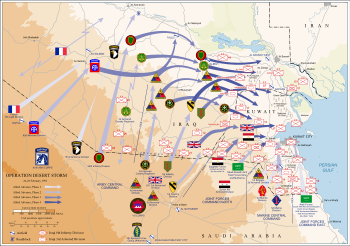 Desert Storm, the 1991 liberation of Kuwait, was launched from Saudi territory and Saudi forces participated in the operation
Desert Storm, the 1991 liberation of Kuwait, was launched from Saudi territory and Saudi forces participated in the operation
When Iraq invaded Saudi Arabia's northern neighbor Kuwait in 1990, Saudi Arabia immediately requested the deployment of US troops within the country to deter further aggression. Saudi forces participated in the subsequent Operation Desert Storm: Saudi pilots flew more than 7,000 sorties and Saudi troops took part in the battles around the Saudi town of Raʾs al-Khafji.[14]
Operation Southern Watch
Main article: Operation Southern WatchSince the Gulf war, the US has had a continued presence of 5,000 troops stationed in Saudi Arabia - a figure that rose to 10,000 during the 2003 conflict in Iraq.[15] Operation Southern Watch enforced the no-fly zones over southern Iraq set up after 1991, as well, the country's oil exports through the shipping lanes of the Persian Gulf are protected by the US Fifth Fleet, based in Bahrain. It was conducted by Joint Task Force Southwest Asia (JTF-SWA) with the mission of monitoring and controlling airspace south of the 32nd Parallel (extended to the 33rd Parallel in 1996) in Iraq, following the 1991 Gulf War until the 2003 invasion of Iraq.
This was one of the stated motivations behind the September 11th terrorist attacks,[15] as well as a the Khobar Towers bombing.[16] Bin Laden interpreted the Prophet Muhammad as banning the "permanent presence of infidels in Arabia".[17] US troops in Saudi Arabia served to provoke skirmishes between Iraq and the US between both Gulf Wars.
Yemen Shia Rebel Offensive
Main articles: Sa'dah insurgency and Operation Scorched EarthOn Nov 5, 2009 the Royal Saudi Land Forces launched a sweeping ground offensive against Yemeni Shiite Hawthi Rebels after they crossed the Saudi border (in order to outflank the Yemeni Army, which had earlier launched a military campaign against the Hawthis to control and pacify the northern Yemeni mountains) and killed 2 Saudi border guards. The Saudi forces relied heavily on air power and artillery to soften the rebels without risking their men. As of Jan 23, 2010 the Saudi Army had lost 113 men in the fighting against the rebels, with most of the casualties occurring when ground forces tried to move into areas that had been softened by shelling.[18]
Military industry
The vast majority of Saudi Arabia's military equipment is imported from European and North American suppliers.[3] However, the Al-Fahd Infantry fighting vehicle and the Al-Faris 8-400 armored personnel carrier, used by Saudi land forces, were manufactured by the Abdallah Al Faris Company for Heavy Industries, based in Dammam.[19]
See also
- King Khalid Military City
- United States Military Training Mission
- Terrorism in Saudi Arabia
- United States withdrawal from Saudi Arabia
- Nuclear program of Saudi Arabia
Notes
- ^ "The Military Balance 2010", p. 269. International Institute for Strategic Studies, London, 2010.
- ^ a b http://milexdata.sipri.org/result.php4 The SIPRI Military Expenditure Database
- ^ a b c d e f g h i Country Profile: Saudi Arabia, Sept. 2006 Library of Congress
- ^ Global Security – SANG
- ^ a b http://www.janes.com/articles/Janes-Military-Communications/Peace-Shield-Saudi-Arabia.html
- ^ "Al Fahd - Wheeled Armoured Reconnaissance/Personnel Carrier - Army Technology". Army-Technology.com. http://www.army-technology.com/projects/al_fahd/. Retrieved 30 August 2010.
- ^ http://www.fas.org/asmp/profiles/saudi_arabia.htm SAUDI ARABIA
- ^ http://middleeast.about.com/od/saudiarabia/a/saudi-arabia-military-aid.htm U.S. Arms Sales to Saudi Arabia
- ^ Arms for the King and His Family
- ^ US-Saudi Security Cooperation
- ^ http://online.wsj.com/article/SB10001424052748704621204575488361149625050.html Saudi Arms Deal Advances
- ^ Gardner, Charles (1981). British Aircraft Corporation. A history by Charles Gardner. B.T. Batsford Ltd. pp. 224–249. ISBN 0-7134-3815-0.
- ^ O’Connell, Dominic (2006-08-20). "BAE cashes in on £40bn Arab jet deal". The Sunday Times (London: News International). http://www.timesonline.co.uk/article/0,,2095-2320097,00.html. Retrieved 2006-08-22.
- ^ Encyclopaedia Britannica Online: Saudi Arabia History
- ^ a b "US pulls out of Saudi Arabia". BBC News. 29 April 2003. http://news.bbc.co.uk/2/hi/middle_east/2984547.stm. Retrieved 29 November 2009.
- ^ Plotz, David (2001) What Does Osama Bin Laden Want?, Slate
- ^ Bergen, Peter L. (2001). Holy War Inc.. Simon & Schuster. p. 3.
- ^ . http://online.wsj.com/article/SB10001424052748704562504575020941128126612.html?mod=WSJ_World_LEFTSecondNews.[dead link]
- ^ Weapons made in Saudi Arabia at GlobalSecurity.org
References
- "Foreign Military Sales, Foreign Military Construction Sales and Military Assistance Facts as of September 2003," Published by Deputy for Operations and Administration, Business Operations/Comptroller, DSCA, Department of Defense
External links
- Ministry of Defense and Aviation, official website
- Royal Saudi Land Forces, official website
- Saudi Arabian National Guard, official website
- Strategic Missiles Force, official website
- General Intelligence Presidency, official website
 Saudi Arabia topics
Saudi Arabia topics- Index
- Outline
History 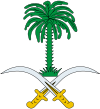
Geography Law Politics - King
- Cabinet
- Allegiance Council
- National Security Council
- Consultative Assembly
- Foreign relations
- Nuclear program
- Mabahith (secret police)
Military Economy Society Culture Symbols Military of Asia Sovereign
states- Afghanistan
- Armenia
- Azerbaijan
- Bahrain
- Bangladesh
- Bhutan
- Brunei
- Burma (Myanmar)
- Cambodia
- People's Republic of China
- Cyprus
- East Timor (Timor-Leste)
- Egypt
- Georgia
- India
- Indonesia
- Iran
- Iraq
- Israel
- Japan
- Jordan
- Kazakhstan
- North Korea
- South Korea
- Kuwait
- Kyrgyzstan
- Laos
- Lebanon
- Malaysia
- Maldives
- Mongolia
- Nepal
- Oman
- Pakistan
- Philippines
- Qatar
- Russia
- Saudi Arabia
- Singapore
- Sri Lanka
- Syria
- Tajikistan
- Thailand
- Turkey
- Turkmenistan
- United Arab Emirates
- Uzbekistan
- Vietnam
- Yemen
States with limited
recognition- Abkhazia
- Nagorno-Karabakh
- Northern Cyprus
- Palestine
- Republic of China (Taiwan)
- South Ossetia
Dependencies and
other territories- Christmas Island
- Cocos (Keeling) Islands
- Hong Kong
- Macau
Military of Saudi Arabia Categories:
Wikimedia Foundation. 2010.

